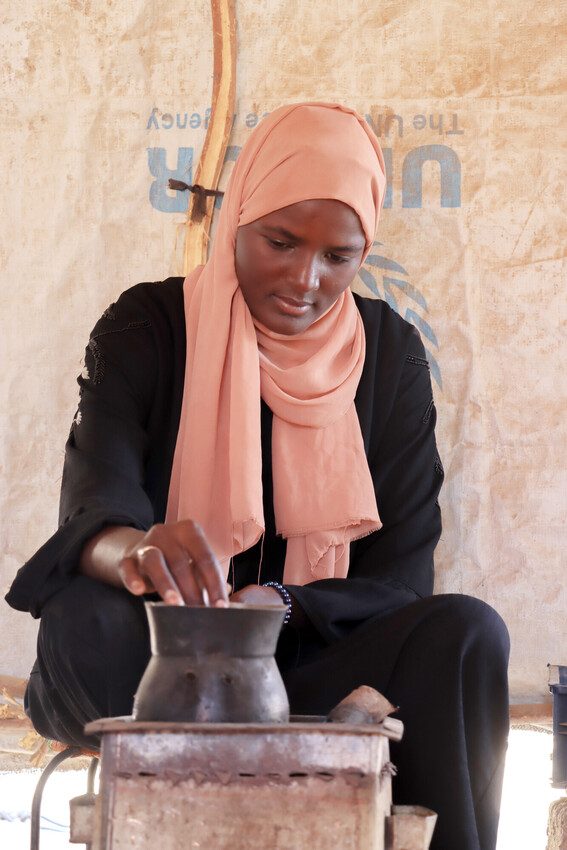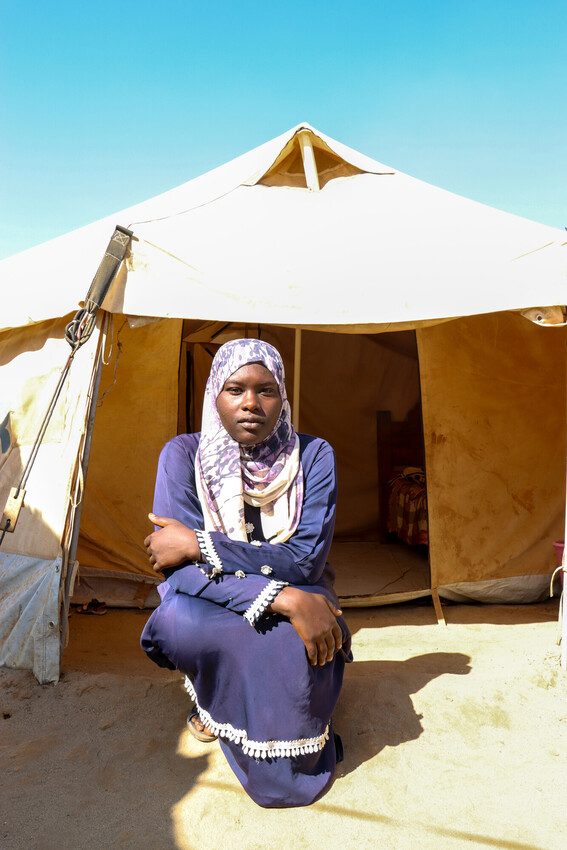Living through two years of conflict
How are girls affected by conflict in Sudan?
Hear from 4 girls who are living through the crisis.

Pictured: Nancy, Mehad and Weam. Image credit: Plan International
Forced to flee their homes
In Sudan 12.6 million people have been forced to flee their homes in the past two years. 8.6 million of these people remain in Sudan, internally displaced, and 53% of these are children under the age of 18.
28% of internally displaced people (IDPs) have experienced secondary displacement and have had to relocate once again due to security concerns.
My life [has] completely changed. It has never gone back to the way it was before.
Weam, 16.
A day in the life of a displaced girl
“My name is Weam, I am 16 years old, from Sinnar State, Sudan.
“On July 1st, 2024, my family and I had to urgently leave our home because of the conflict. We travelled by truck with 15 other families. The journey was very hard – we suffered under the hot sun, and later, it rained on us as we made our way to Gedaref. When we arrived, the people there welcomed us kindly and I was very grateful.
“There were no houses available, so we had to stay in an empty office that had no doors or windows. We put sacks on the ground to sleep on and life was very difficult. It was the rainy season, and it rained all the time. We decided to leave for an internally displaced persons camp in Kassala.
“When we arrived at the Kassala camp, my life completely changed. It has never gone back to the way it was before.
“There is a school in our camp, it has classes three days a week for girls and three days for boys. I can’t find a part time job right now though.
“My daily routine involves me waking up in the morning, brushing my teeth, praying, and studying.
“Then, I prepare breakfast, and we all eat together.
“In the afternoon, we make coffee, and I pray, visit my friends, and spend time with my mother and sister before going to sleep.”


Mohira works to help her family
“After being displaced, our father died and my mother had to work. She started selling lupine and beans. But the situation worsened and all the family’s sources of income were cut off,” says 19-year-old Mohira.
“After about a month, Dar El Salam was also attacked by armed groups, so my family and I moved to a remote area about 9 hours away on foot. It was hard walking, especially after we ran out of food and water.
“When Plan came to the shelter, they held awareness sessions and provided psychological and social support. We found some reassurance in that.
“I work selling beans, dukkah, lollipops and chewing gum. I go to the market but often don’t make any sales, which is another challenge. When I do make a sale, I use it to help my family with their basic needs.”
Mehad worries about her education
“When we arrived in Kassala, we stayed in a school that was used as a camp for displaced families for about a month and a half. Unfortunately, it was the rainy season and a big flood hit the camp. My aunt, who was staying with us, lost her life in the disaster,” says Mehad, 18.
“After the flood, we moved to another camp. Living conditions there were also difficult, especially during the rainy season. However, once the rainy season was over, we managed to adapt and cope with our new surroundings.
“Despite settling in Kassala, one of my biggest problems is education. The school system here is very different from what I was used to. In this new school, we sit on the floor and textbooks are scarce – each student has only one or two notebooks.
“The teaching is incomplete and with only partial lessons, we are not getting the education we need to secure our future.
“As I prepare for my Sudanese certification exams, I face big challenges. Without textbooks, I rely on what I learn in class. The school is only open three days a week, which is not enough to prepare properly.
“On top of that, my daily chores include fetching water from far away, which makes my life difficult. The war has completely changed my life.”


Nancy’s mental health has suffered
“Having a safe place to stay is the most important thing for any human being, but life in the camp is still very hard,” says 18-year-old Nancy.
“I am a high school student and sat for the Sudanese certificate exams on 28 December 2024. Before the conflict, I lived a happy and peaceful life in my village. But now I feel depressed.
“We have no stable source of income, I miss my friends and family, and this difficult situation makes me feel sad all the time. Once, because of the stress, I became very ill and had to be taken by ambulance to the city hospital.
“We struggle with heavy rains in the camp and suffer from hunger. My father was unable to find a job despite looking for one. To support our family, he started collecting firewood, which we then sold to pay for our daily needs.
“I am the eldest child in my family and all my younger brothers and sister are still very young. We receive some support from humanitarian organisations, and we are very grateful. However, the aid we receive is not enough to cover all our needs, so we continue to sell firewood.”
A devastating humanitarian crisis
Two years of conflict in Sudan has resulted in a catastrophic crisis that will take a lasting toll on girls’ lives.
More children in Sudan have been forced from their homes than anywhere else in the world.
Nearly two thirds of Sudan’s population — more than 30 million people — will require humanitarian assistance in 2025. Of these, 16 million are children.
Plan International Sudan is working tirelessly to reach children and their families in North Darfur, White Nile, Kassala Al Gadaref and the Kordofan. We are also working to support refugees in South Sudan, Egypt, Ethiopia, Chad and CAR.
We are working to address a range of needs such as water, sanitation, and hygiene, child protection, food security, health and nutrition, shelter, education and mental health support.
